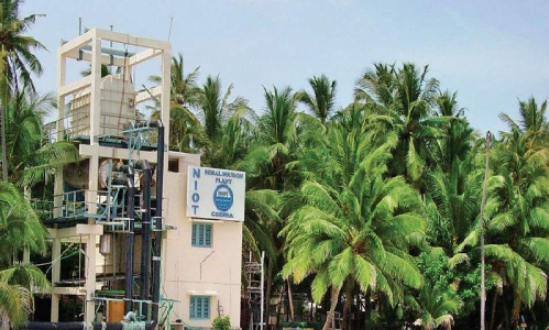Scientists at the National Institute of Ocean Technology, Chennai develop world’s first low temperature thermal desalination plant (LTTD), which could address drinking water problems in India’s ocean island territories and even offshore urban centres along the coastline. LTTD is one process that uses the availability of a temperature gradient between two water bodies or flows to evaporate the warmer seawater at low pressures and condense the resultant vapour with the colder seawater to obtain fresh water.
Chennai (ISJ) – Scientists at the National Institute of Ocean Technology (NIOT), Chennai have developed world’s first low temperature thermal desalination plant, which could address drinking water problems in India’s ocean island territories and even offshore urban centres along the coastline. Low temperature thermal desalination (LTTD) is one process that uses the availability of a temperature gradient between two water bodies or flows to evaporate the warmer seawater at low pressures and condense the resultant vapour with the colder seawater to obtain fresh water.
“The 12-13°C cold water available at about 400m depth within 600m from the island is used along with the surface water at about 28°C to produce potable water in the Lakshadweep Islands,” Dr Ramana Murthy, Scientist at NIOT told Indian Science Journal. “The simplicity of the LTTD process also enables to control the quality of product water in order to provide potable drinking water.”
While the cost of desalinated water would depend on the technology used and cost of electricity, which varies from place to place, according to cost estimates made by an independent agency for LTTD technology, it works out to 61 paise per litre for Island based plants. The technology is environment friendly, completely indigenous with low operational and maintenance issues and with long-term sustainability.
The remote Lakshadweep islands have been facing drinking water scarcity with increasing population and higher tourists’ inflow. The plants set up by NIOT in Karavatti, Minicoy and Agatti cater to the requirements of the local population. NIOT is setting up more plants in the union territory in the islands of Androth, Amini, Kadamat, Kiltan, Kalpeni and Chetlat with a capacity of 1.5 Lakh litre each per day for which the work has already been initiated. The completion of these 6 plants will resolve the water problem in Lakshadweep islands and drinking water is provided all inhabited islands.
Dr Atmanand, Director said NIOT is currently scouting for public-private partnership for further development of the technology to upscale the capacity to the tune of 10 million litres a day (MLD) for offshore requirements.
“One of the advantages of the process is that it can be implemented even with a low temperature gradient of about 8-10°C between two water bodies, with no additional requirement of heating/cooling,” Dr Atmanand said.M
Even though flash distillation is a commonly used desalination process worldwide and especially in Middle East, none of the established plants work with the temperature gradient as low as 8°C as is possible in the LTTD process.
Installation of LTTD projects is not without any technical challenges. Site-specific design and installation of 950 m long pipeline to draw cold water from 350 metre depth and marine structure to draw cold/warm water and to support the pipeline is a major challenge. As the sea bed topography and environment are different in each island, the design of marine structures and cold water pipe was prepared considering site specific conditions of respective island. The marine structures consist of three major structural components – intake sump to draw cold/warm water; approach trestle carrying cold/warm water from sump to plant building and also providing access from shore to the sump; and, plant building to house process equipment. The intake sump has to be provided at 5m water depth contour, and length of the bridge depends on the distance of this depth contour from the shore and NIOT has specialised in design and implementation of marine structure, deep sea cold water pipe and process equipment, Dr. Murthy said. These plants can be easily be established in Maldives, Mauritius and some of the pacific islands and found be best technology for remote islands, as there is no maintenance .
Dr Atmanand said, LTTD technology was also demonstrated using waste heat generated from the North Chennai Power Plant to produce fresh water. The demonstration plant has a capacity of one lakh litres per day. NIOT has also commissioned a barge-mounted plant of 1 million litres per day off Chennai, which once scaled up can address drinking water shortage in the southern metropolis.


